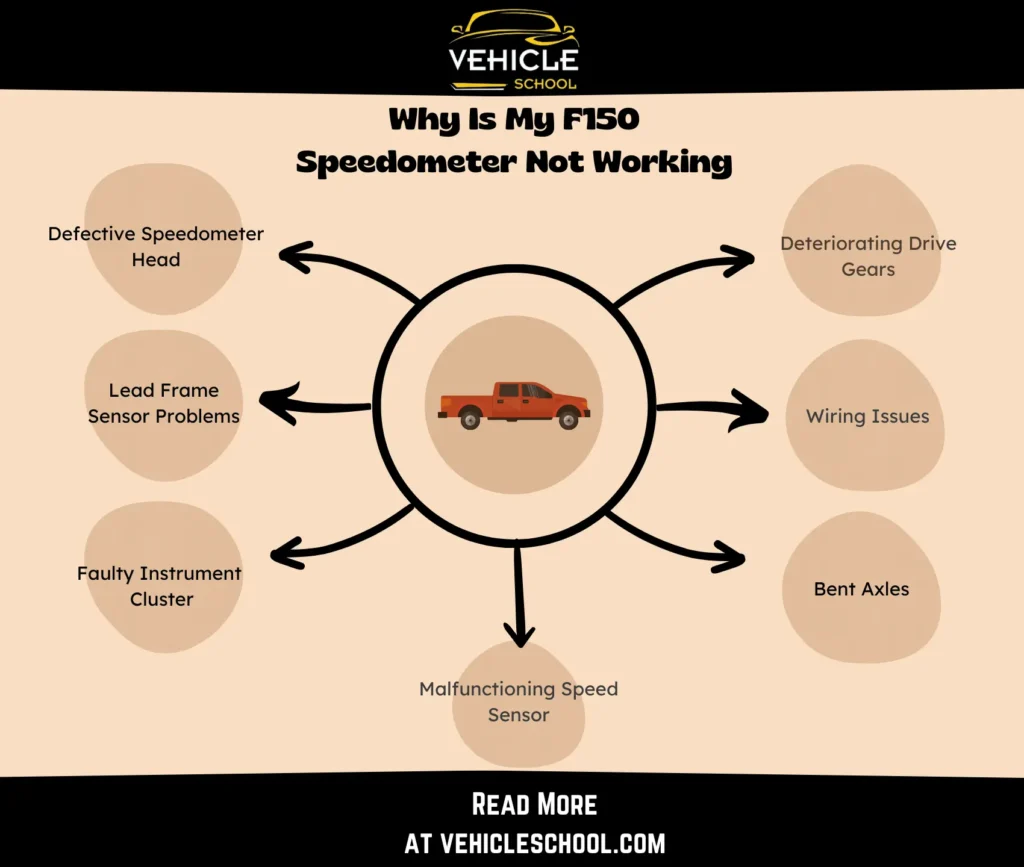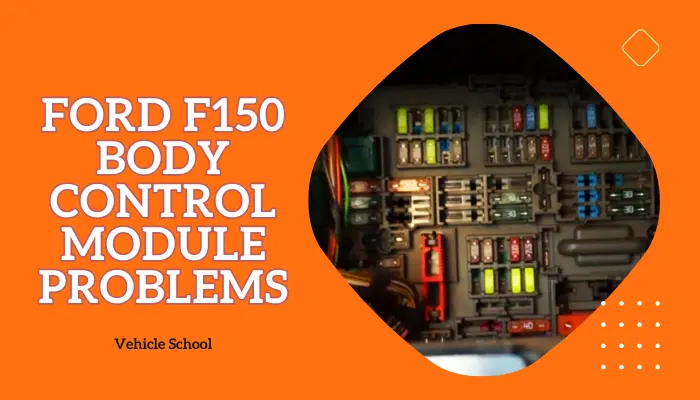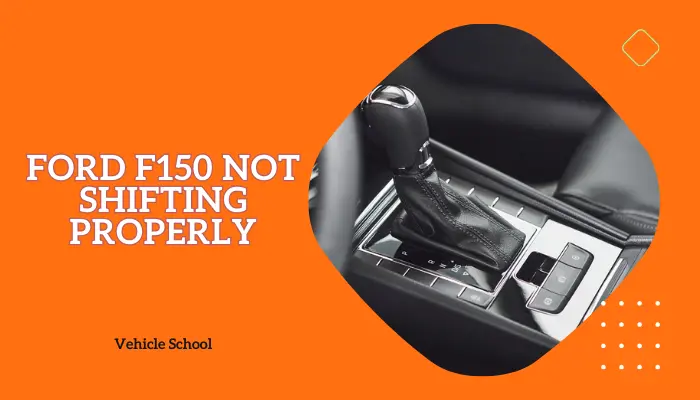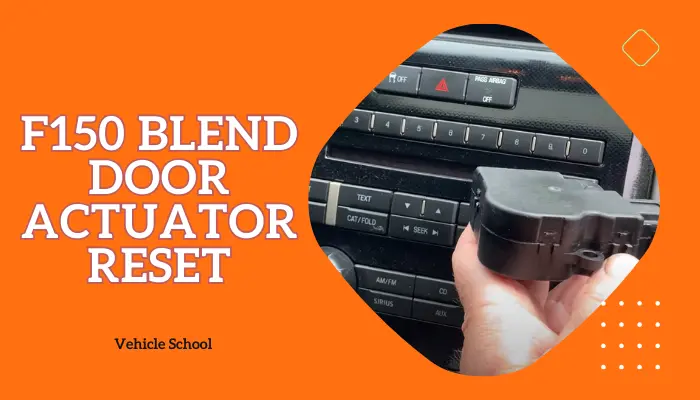Is the speedometer on your Ford F150 not working? I’ve been there too. Exploring forums and talking to truck owners confirmed it’s a common issue.
In this article, I’ve shared all the details on why the speedometer on the f150 stops working and how to fix this issue. So, keep reading.
Why Your Ford F150‘s Speedometer Is Not Working?
Your Ford F150’s speedometer is not working due to worn gears in the speedometer, wiring problems, bent axles, or faulty sensors. To fix this problem you’ll need to swap broken drive gears of your truck’s speedometer, fix wiring, replace axles or sensors and recalibrate the speedometer.
Let’s start by going through the causes in detail.

1. Broken Drive Gears of Speedometer
The mechanical components within the drive gears of your truck’s speedometer can experience wear and tear over time.
This wear and tear can cause imprecise readings or a complete failure of the speedometer.
2. Speedometer Cable Fault
Faulty or damaged wiring within the speedometer system can disrupt communication between different parts.
This disruption may prevent the accurate transmission of speed data, resulting in a malfunctioning or non-functional speedometer.
3. Axles Are Damaged Or Bent
If the axles that connect the speedometer to the truck’s wheels become bent or damaged, it can interfere with the proper rotation and transmission of speed data.
This can cause the speedometer to provide wrong readings or cease to function altogether.
4. Broken Speedometer Head
A broken speedometer head, which is the part with the numbers and all the inside bits, can mess up your speedometer and not show the right speed.
5. Lead Frame Sensor Issue
The lead frame sensor, which works with the electronic parts in the speedometer, can run into problems like rust or damage.
If there’s an issue with the lead frame, the electronic parts in the speedometer might not work right, causing the speed readings to be off.
This issue also makes the wrench light come on and F150 transmission problems.
6. Instrument Cluster Is Broken
The instrument cluster, where you find the speedometer, odometer, and other gauges, might run into problems like electronic glitches or display issues.
When this happens, it can throw off its components, including the speedometer itself.
7. Speed Sensor Has Malfunctioned
The speed sensor, located on the output shaft of the transmission, measures rotations and transmits speed data to the vehicle’s Electronic Control Unit (ECU).
A malfunctioning speed sensor, resulting from electrical issues or sensor damage, can lead to a failure to register speed data.
How To Fix The Speedometer Of Your F150?
Here are the solutions you can try. Just as a reminder, don’t forget to record the date and mileage if you do any replacements.
1. Change The Drive Gears Of Speedometer
- Park on a flat surface, apply the parking brake and use wheel chocks.
- Find the speedometer drive gear inside the VSS.
- Use snap ring pliers to take off the snap ring.
- After removing the snap ring, push the drive gear forward with some force.
- Use a small magnet to get the small ball from behind the drive gear.
- With the ball out, pry around the gear if needed to remove it.
- Check the old gear for wear or damage; if damaged, swap it.
- Put back any components you removed, like the snap ring.
- Start the truck, check the speedometer, and go for a short drive to check transmission shifts.
- Ensure all components are secure and check for leaks.
Watching this video could assist you in performing this fix:
Doing all these can also possibly help out with any transmission problems on your F150.
2. Fix The Cable Of Speedometer
The most likely wiring issue is probably the speedometer cable. You’ll need some tools to fix it as well as the following steps:
- Gather these tools: Phillips screwdriver, flathead screwdriver, 10mm socket, pliers, sharp razor blade and towel.
- Remove the lower dash panel (3 screws, disconnect plug).
- Take out the middle dash panel (10mm bolt, pop-out panels).
- Unscrew 6 screws to remove cluster housing and gauge cluster.
- Disconnect the speedometer cable and release the clip.
- Pop out the gray grommet, pull the cable through the firewall and unclip.
- Confirm replacement cable and check for a 90-degree adapter.
- Lubricate and screw the new cable into the transmission.
- Route cable along the firewall, use the original grommet if needed.
- Reconnect cable to gauge cluster and attach housing (6 screws).
- Reassemble middle and lower dash panels.
- Reconnect electrical plugs.
- Clean interior components.
- Ensure all panels are secure.
- Start your F150 and test the speedometer.
- Take a short drive to verify cable functionality.
3. Replace The Axle Shaft
If you’ve got bent axles, you’ll need to replace the axle shaft. Here’s what you can try:
- Safely secure the vehicle and disconnect the brake system.
- Remove the rear wheels to access the brake components.
- Extract the differential cover and drain fluid.
- Remove pinion shaft, axle shaft, and associated components.
- Replace it with a new axle shaft and secure the components.
- Clean and prep-seal surfaces.
- Apply the silicone gasket maker and reattach the differential cover.
- Refill with differential fluid.
- Reinstall the rear brake system.
- Replace wheels, lower the vehicle, and block wheels.
- Complete the process by refilling the brake fluid and resetting the brake pads through pedal pumping.
- Drive cautiously for the initial 30 miles to ensure a proper break-in.
4. Fix The Defective Speedometer Head
For your speedometer head, you’ll most likely need to fix the needle, which falls out sometimes. Here’s how you can do that:
- Disconnect the battery by loosening the 8mm terminals.
- Use a 7mm wrench to remove two screws and pop off the faceplate.
- Find and unscrew other 7mm screws around the instrument cluster.
- Gently pull out the instrument cluster; unplug if needed.
- Check the speedometer needle for issues.
- If the needle is loose or broken, glue it back with fast-setting Gorilla Glue.
- Apply glue to fix any cracks in other components, like the tachometer.
- Let the glue set for a strong bond.
- Put the instrument cluster back together, following the reverse steps.
- Reconnect the battery terminals.
- Check if the speedometer needle works correctly.
- Secure the instrument cluster with screws.
- Confirm all parts are in place and working.
- Reconnect the battery, start the vehicle, and check the speedometer.
5. Replace The Lead Frame Sensor
- Drain transmission oil using a 19mm socket.
- Optionally use an oil pump for oil extraction if there’s no drain plug.
- Remove the transmission oil pan to access the valve body and sensor.
- Disconnect the sensor’s electrical connector.
- Take off 11 flat-headed bolts securing the valve body.
- Replace the old sensor with the new one (secured by five bolts).
- Cover the sensor’s connectors with the provided rubber piece.
- Reassemble the valve body, ensuring proper placement of rubber pieces and connectors.
- Reconnect the electrical connector and secure the valve body with bolts.
- Reattach the oil pan and fill the transmission with oil.
- Test drive to check for smooth shifting and address any leaks or unusual noises.
Doing this should also help get rid of any issues with the speed sensor.
6. Change The Instrument Cluster
Ford has a TSB on this. The issue is mostly present on the 2015 F150; for specific instructions on changing that cluster, check out the WSM page mentioned in the TSB.
Below are the steps I’ve followed for changing the instrument cluster on a newer 2018 Ford F150:
- Turn off the ignition.
- Remove the center dash part gently.
- Unsnap surrounding components and unscrew the 7mm screws on the cluster bezel.
- Fold down the bezel and disconnect the wiring.
- Grab the top of the cluster, pull it towards you, and unplug the remaining connectors.
- Note the part number for the replacement cluster.
- To install the new cluster, reverse the steps, ensuring tabs are properly aligned.
7. Replace The Speed Sensor
Before we get to this fix, do note that I’ve only done it on older F150s. The below steps will work if you have a 1997-2003 F150. For a newer model, you’ll have to look it up in your model’s service manual.
- Locate the output shaft speed sensor on the driver’s side of the transmission.
- Unplug the sensor and remove the securing bolt with an eight-millimeter socket.
- Twist and gently pry out the old sensor.
- Optionally lubricate the O-ring on the new sensor.
- Insert the new sensor until it clicks into place.
- Tighten the securing bolt snugly but not too tight.
- Plug in the electrical connector until it clicks.
- Take the vehicle for a road test to see if the speedometer works again.
How To Reset The Speedometer On A Ford F150?
To directly reset the speedometer without any special tools you can do a soft reset or a hard reset. The soft reset will reset the whole instrument cluster itself, so it will reset the speedometer as well. Here’s how to do it:
- Turn the ignition on without starting the car.
- Press and hold the multi-instrument display or MID button on the steering wheel or dashboard.
- If the above steps don’t work, locate the reset button below the instrument cluster on the right side of the dashboard.
- Press and hold the reset button.
- While holding the reset button, turn on the ignition key without starting the car.
- Look for a “sweep gauges” sign or observe as the gauges reset to their correct positions.
Now this is how you do a hard reset on your F150’s speedometer:
- Turn off your Ford F150 and ensure it’s completely stopped.
- Pop open the fuse panel in the engine compartment by pressing on both sides.
- Locate the “ODO/TRIP” fuse (15 amp or 20 amp) and pull it out, remembering its orientation.
- With the fuse out, your speedometer is now reset.
- Put the fuse back in, ensuring the top side is at the bottom.
- Close the fuse panel by pressing both sides until it clicks.
- Reconnect the speedometer Ford connector.
- Turn the key to the “on” position (without starting the truck).
- Start the truck; the speedometer needle should show zero.
- Once everything’s done, check to see if the speedometer displays the correct speed.
Wrapping Up
You won’t have to stress about speeding tickets in your F150 anymore. These fixes have your back, ensuring your speedometer is on point.
Ride confidently without dealing with unintentional violations, just hit the road and enjoy.






